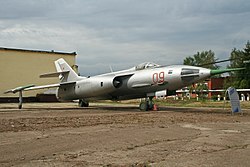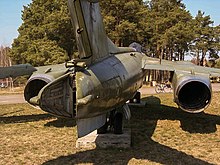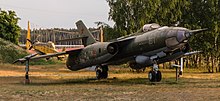Yakovlev Yak-28
| Yakovlev Yak-28 | |
|---|---|
 Jak-28L |
|
| Type: | * Interceptor |
| Design country: | |
| Manufacturer: | |
| First flight: |
March 5, 1958 |
| Commissioning: |
1962 |
| Production time: |
1959-1972 |
| Number of pieces: |
1,180 |
The Jakowlew Jak-28 ( Russian Яковлев Як-28 , NATO code name : “Brewer” or “Firebar” or “Maestro” ) was a twin-engine Soviet fighter aircraft. It was the last link in the development series Jak-25 , Jak-26 , Jak-27 .
development
The first prototype, designated Jak-129 , was equipped with R-11A-300 engines and flew for the first time on March 5, 1958. It completed flight tests by October 4 of the same year. Due to the lack of directional stability, the wings were then given two additional boundary layer fences . However, after further deficiencies had occurred, the state examination commission refused the acceptance, which is why two more prototypes were created, the Jak-28-2 with R-11AF-300 and the Jak-28-3 with R-11AF2-300 engines . This time all tests were successfully completed and the Yak-28 was put into production at Irkutsk Plant No. 39 and Plant No. 153 Novosibirsk .
It appeared in the main versions in the early 1960s as an interceptor aircraft ( Jak-28P ), front-bomb aircraft ( Jak-28B ) and reconnaissance aircraft ( Jak-28R ). The type was presented to the public for the first time on June 1, 1961 at the air parade in Tuschino , the delivery of the first series machines began in 1962. In contrast to its predecessors Jak-26 and Jak-27 , however, the Jak-28 appeared as a shoulder- wing aircraft for the large Tumanski R-11 engines equipped with an afterburner to create sufficient ground clearance. The last remaining Yak-28s were decommissioned in 1992.
commitment
During the Afghanistan conflict from December 1979 a total of three units equipped with Yak-28s were deployed in the war. First, the 87th Independent Reconnaissance Air Regiment (ORAP) carried out night reconnaissance flights from Karshi airfield in Uzbekistan. Other parts of the unit were stationed in Kokaidy and Kandahar . A squadron of eight Yak-28Rs of the 39th ORAP moved to Mary Airfield in Turkmenistan on December 25, 1979 and immediately began reconnaissance flights over Afghanistan. Another part of the unit was also stationed in Karshi. While the 39th regiment was relocated back to its home base in Balkhash / Kazakhstan in April 1980 , the 87th ORAP remained in action and replaced its Jak-28 with a Su-24MR in 1987 .
In February 1980 there was a confrontation with Iranian F-14s across the Afghan-Iranian border . The Yak-28R of the crew of Roslyakov / Gabidulin from the 87th ORAP carried out a reconnaissance mission and apparently violated Iranian airspace, whereupon two interceptors took off from the base in Mashhad . The crew of the Yak-28 noticed the aircraft and tried to escape at a height of about 20 meters in low flight. However, the F-14 could not be shaken off. Only after they had already penetrated Soviet airspace in the Kurchka area did they finally turn away.
The 149th Guards Bombing Regiment (GwBAP) transferred its Jak-28I to Karshi on December 13, 1979, where it remained in constant readiness for action and carried out training flights . On the night of January 6th to 7th, 1980, the first war operation against registered marching troops took place, with cluster bombs of the type RBK-500 being dropped. A total of 14 missions took place in January, mainly against troop concentrations of the Mujahideen . On February 22nd and 26th, however, attacks were carried out on Kabul in support of the ground forces . The deployment of the 149th GwBAP ended on March 7, 1980 with the relocation to the home base in Schetigen near Nikolaevka in Kazakhstan.
Three Jak-28s were lost during the mission. On February 4, the Yak-28I of the Lebedev / Nagli crew missed the runway in heavy fog when approaching the Karshi base and crashed into an earth wall. The aircraft exploded and the crew was killed instantly. In a Jak-28R of the 87th ORAP, the take-off from Kokaidy had to be aborted due to a sudden loss of engine power. The machine shot over the end of the runway into an irrigation ditch. The fuel tank was ripped open and the Jak-28 caught fire. The crew was able to free themselves from the wreck and survived, the plane exploded a short time later. The only loss during a mission was on April 15, 1987 and was probably caused by a Stinger anti-aircraft missile. The Chisteev / Ponarenko occupation had to disembark over mujahideen-controlled territory and was most likely killed by the insurgents.
Overall, the deployment in Afghanistan showed that the Jak-28 - especially the Jak-28I bomber version - no longer met the requirements. The aircraft of the 149th GwBAP were replaced by Su-24s after their return.
Versions
- Jak-28
- The first series was identical to the second prototype Jak-28-2 and designed as a tactical bomber. She didn't have radar. Only a small series emerged, the existence of which was not known to the western states and which was therefore not given a NATO code name.
- Jak-28B
- It was the second production version as a tactical bomber, the prototype of which (yellow 74) first flew in 1959. It was equipped with a 360 ° rotating radar RBP-3 in a bulge under the pilot's cabin and a fifty-round NR-23 cannon . Only a few machines were built in 1960, and bomber production was quickly transferred to the Jak-28L. In 1961 the model was presented to the public at the Tushino air parade. From March 20 to April 4, 1962, tests were carried out on a series machine with two SPRD-118 starting aid missiles on the rear fuselage and an automatic braking parachute system. The trials were successful and their results were incorporated into production. The Jak-28B received the NATO code "Brewer-A".
- Jak-28BI
- A Jak-28B equipped with a high-resolution directional radar Bulat and ground penetrating radar Iniziatiwa-2 was designated as Jak-28BI in 1965.
- Jak-28L
- The all-weather bomber design was derived from the third prototype Jak-28-3 and appeared in 1962. The abbreviation L refers to the used electronic bomb aiming device Lotos, which, however, was not very reliable. It was introduced into the troops from 1963. The bomb bay was located in the middle fuselage section, but external loads could also be carried at two underwing stations. The NR-23 cannon was replaced by a GSch-23Ja in the course of production . The navigator's workstation in the bow turned out to be inadequate, so that production was transferred to the Jak-28I after only 111 machines. The NATO code is "Brewer-B".
- Jak-28I
- All-weather bomber and fighter-bomber version with Iniziatiwa-2 ground radar, which could also be used as a nuclear weapon carrier, was delivered from 1963. The prototype (yellow 24) was initially equipped with R-11AF-300 engines, but later received R-11AF2-300, which were retained. There were 223 pieces that were given the NATO code "Brewer-C".
- Jak-28IM
- This version from 1969 was an attempt to modernize (m for modified) and increase the combat value of the Jak-28I with four additional pylons for weapons and equipment. Because the serial production of the Sukhoi Su-17 and Sukhoi Su-24 had already started , there was no series production.
- Jak-28N
- Version of the Jak-28I for two air-to- surface missiles Ch-28 on pylons under the wings.
- Jak-28R
- a reconnaissance version developed from the Jak-28I (Raswedtschik = reconnaissance), which, like the Jak-28L, had a glazed fuselage bow, but was equipped with an inclined glass-metal transition and flew for the first time in 1963. A multi-sensor platform with optical cameras, side-view radar and other sensors was integrated in the bomb bay. The NATO code for this type is "Brewer-D". The tank capacity has been increased by 550 liters. 183 pieces were built in Irkutsk from 1966 to 1970.
- Jak-28RR
- It was a special reconnaissance version for nuclear radiation reconnaissance in the air (RR = радиационный разведчик). A few Jak-28R were converted in this way in the 1960s. The equipment was in RR8311-100 canisters under the wings.
- Jak-28RL
- This was an improved test version of the Jak-28R for radio reconnaissance with a normal transition from bow to fuselage. A serial Jak-28L (blue 06) was converted as a test vehicle. The radio equipment was in the RR8311-100 wing containers.
- Jak-28PP
- This was a special version as an ECM aircraft for electronic warfare . PP stands for Postanowtschik Pomech (disruption organization). All unnecessary equipment had been removed and replaced by jamming systems of the types Strela, Buket, Fasol-1 and SPS-153. It was used from 1970 to the beginning of the 1990s. The NATO code was "Brewer-E".
- Jak-28N
- Prototype of an anti-radar version with RLS radar and Ch-28 missiles derived from a Jak-28I , which was tested in 1965 but did not go into production.
- Jak-28P
- An all-weather interceptor version, NATO code "Firebar", which was delivered to the air forces from 1965 and presented to the public in 1967. The bow of this model consisted of a pointed nose made of polystyrene , under which the large Orjol-D radio measuring device was located. The two crew members sat behind one another in the cockpit taken over from the Jak-27. The bomb bay was replaced by a 4570 liter tank. Production took place in Novosibirsk plant No. 153 and included 435 Jak-28P. At the end of 1985, around 150 copies are said to have been in use in air defense. The P in the abbreviation stands for Perechwatschik, in German interceptor.
A modified version with an extended nose tip and rearwardly offset inner wing carriers for R-3S missiles went into production from 1966.
- Jak-28PM
- This was an improved version of the Jak-28P with more powerful Tumanski R-11AF3-300 engines from 1963, which allowed the aircraft to reach a top speed of 2400 km / h. Since the engine did not go into production, the PM also remained a prototype.
- Jak-28SR
- This was a version with the jammer SPS-141 (Stanzija Pomechowych Signalow) or SPS-143. The prototype - a converted serial Jak-28R - flew for the first time in 1970. The number of units built was very small.
- Jak-28U
- This all-weather training machine, listed as “Maestro” in the NATO designation system, had a second cockpit for the trainee pilot, which was placed in front of the normal cabin in tandem. The aircraft had double controls, a 1350 liter tank in the bomb bay and a metal nose tip. Two R-11AF-300s served as propulsion. The prototype Jak-129U was tested from July to September 1962. From the end of 1962, the Jak-28U was built in a number of 183.
- Yak-28URP
- For test purposes, a standard Jak-28P was equipped with additional rocket engines in order to increase speed and altitude. However, this concept was not pursued any further.
- Jak-28-64
- In this prototype, as an alternative to the Sukhoi T-58D, the later Su-15 , the two engines were integrated into the fuselage, which kept the middle fuselage section wider. Two additional containers could be carried under the fuselage on two suspensions. The armament consisted of two R-8M1 missiles under the wings. Development began in 1964 and testing was carried out in 1966. Due to poor flight performance, there was no series production.
Others
On April 6, 1966, a crashed on the airfield Finow Eberswalde stationed Yak-28 of the 16th Air Army in the located in the British sector of Berlin Stoessensee . The British recovered the bodies of the crew members who had died in the accident and handed them over to the Soviet authorities. Today there are memorial stones on the Soviet garrison cemetery in Eberswalde and in the Aviation Museum in Finowfurt .
→ Crash of a Soviet Yak-28 in the Stößensee
In August 1968 Jak-28R of the 11th Independent Reconnaissance Air Regiment carried out reconnaissance missions over the territory of the ČSSR as part of the crackdown on the Prague Spring from the Neu-Welzow airfield .
technical description
The Jak-28 was built in all-metal half-shell construction.
The fuselage encloses three sections: The bow contained either the radio measuring device (fighter) or the cabin of the navigator (bomber / reconnaissance aircraft) as well as the pilot's cabin, the shaft of the nose wheel landing gear and the navigation equipment / bomb sighting device. In the reconnaissance / bomber version, the Jak-28 had a glass bow pulpit, which was the workplace of the navigator / bombardier. The hunting versions were equipped with a closed bow.
In the middle of the fuselage were the fuel tanks, the connections for the wings, the electronic equipment and, in the case of the bomber version, the bomb bay. The rear section was used to accommodate the rear wheel and had a warning device at the end to detect enemy fighters.
The cantilever two-spar wings were swept more heavily between the fuselage and the engine (44 °) than in the outer area (35 °). The leading edge of the wing had a saw tooth . On each side, the upper wing side had a boundary layer fence .
The tail unit had a rising keel, a high mounted horizontal stabilizer with a 40 ° sweep and a stabilizing fin under the stern, also known as a false keel . The vertical stabilizer was significantly higher than that of the Jak-25.
The tandem landing gear adopted by the Jak-25 consisted of the nose wheel, the main wheel and two support wheels at the ends of the wings.
Military users
Technical specifications

| Parameter | Jak-28L | Jak-28P |
|---|---|---|
| span | 12.50 m | 12.95 m |
| length | 21.65 m | 23.00 m |
| height | 3.96 m | 3.95 m |
| Wing area | 37.50 m² | 37.60 m² |
| Empty mass | 13,600 kg | k. A. |
| Takeoff mass | normal 16,000 kg maximum 19,000 kg |
19,000 kg |
| Engines | two teaspoons of Tumanski R-11 | two teaspoons of Tumanski R-11AF2-300 |
| power | 46 kN each without afterburner 62 kN each with afterburner |
59.5 kN each without afterburner 60.8 kN each with afterburner |
| Top speed | 1,460 km / h at an altitude of 10,000 m | 2,007 km / h |
| Cruising speed | 920 km / h at an altitude of 11,000 m | 925 km / h |
| Rate of climb | 142 m / s | k. A. |
| Summit height | 17,000 m | 16,750 m |
| Range | 2,570 km | normal 925 km maximum 1,600 km |
| Armament | a 23-mm automatic cannon NR-23 or GSch-23 Yes 4,000 kg bombs |
two air-to-air guided missiles Kaliningrad K-8 |
| crew | 2 men | |
Armament
- Internal guns
- 1 × 23 mm automatic cannon Nudelman-Richter NR-23 at 50 rounds of ammunition (only Jak-28B)
- 1 × 30 mm automatic cannon Nudelman-Richter NR-30 with 80 rounds of ammunition
- 1 × 23-mm automatic cannon Grjasew-Schipunow GSch-23 (9A472) with 150 rounds of ammunition (from Jak-28L)
- Gun loading of 4,000 kg in an internal gun bay and at two external load stations under the wings
- Air-to-air guided missile
- 2 × PU-1-8 start rails for 1 × Bisnowat R-8MR / M1R (AA-3 "Anab") each - radar-controlled for medium -haul routes
- 2 × PU-1-8 start rails for 1 × Bisnowat R-8MT / M1T (AA-3 "Anab") each - infrared- controlled for medium- haul routes
- 2 × BD3-60-21U start rails for 1 × Wympel R-3S (K-13A or AA-2 "Atoll") each - infrared controlled for short distances
- Air-to-surface guided missile
- 2 × Raduga Ch-28 (AS-9 "Kyle") - passive radar-guided for radar combat
- Free falling bombs
- 1 × FAB-3000 (3,000 kg free-fall bomb )
- 2 × FAB-1500 (1,500 kg free-fall bomb)
- 1 × free-falling 1,200 kg nuclear bomb
- 2 × FAB-500 (500 kg free fall bomb)
- 2 × RBK-500AO-2,5RT (338 kg bulk bomb with 108 AO-2,5RTM bomblets)
- 4 × FAB-250 (250 kg free fall bomb)
- 8 × FAB-100 (100 kg free fall bomb)
- External container
- 1 × drop-off additional tank for 1,000 liters of kerosene
literature
- Wilfried Copenhagen : Soviet fighters . Transpress, Berlin 1985.
- Rainer Göpfert: Jakowlew's most successful post-war aircraft: Jak-28 front-bomb aircraft . In: FliegerRevue . No. 7/2017 , p. 48-53 .
- William Durie: The British Garrison Berlin 1945–1994: A Pictorial Historiography of the British Occupation . Past Publishing, Berlin 2012, ISBN 978-3-86408-068-5 .
Web links
Individual evidence
- ↑ Joachim Barschin: Jakowlews Zweistrahler in War and Peace. In: Flieger Revue Extra , No. 8/2005. ISSN 0941-889X . P. 103.
- ↑ Ulf Gerber: The great book of Soviet aviation 1920–1990. Development, production and use of the aircraft. Rockstuhl, Bad Langensalza 2019, ISBN 978-3-95966-403-5 , p. 596
- ↑ Joachim Barschin: Jakowlews Zweistrahler in War and Peace. In: Flieger Revue Extra , No. 8/2005. ISSN 0941-889X . Pp. 109-113.
- ^ Kazakhstan Airfields. www.globalsecurity.org, accessed on May 29, 2019 .
- ↑ AviationsMilitaires.net - Zhetigen (Kazakhstan). www.aviationsmilitaires.net, accessed on May 29, 2019 (French).





